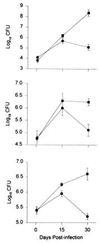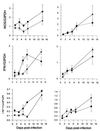Effects of protein calorie malnutrition on tuberculosis in mice
- PMID: 8962145
- PMCID: PMC26226
- DOI: 10.1073/pnas.93.25.14857
Effects of protein calorie malnutrition on tuberculosis in mice
Abstract
Infectious diseases and malnutrition represent major burdens afflicting millions of people in developing countries. Both conditions affect individuals in industrialized nations, particularly the aged, the HIV-infected, and people with chronic diseases. While malnutrition is known to induce a state of immunodeficiency, the mechanisms responsible for compromised antimicrobial resistance in malnourished hosts remain obscure. In the present study, mice fed a 2% protein diet and developing protein calorie malnutrition, in contrast to well-nourished controls receiving a 20% protein diet, rapidly succumbed to infection with Mycobacterium tuberculosis. Malnourished mice exhibited a tissue-specific diminution in the expression of interferon gamma, tumor necrosis factor alpha, and the inducible form of nitric oxide synthase in the lungs, but not the liver. The expression of these molecules critical to the production of mycobactericidal nitrogen oxides was depressed in malnourished animals in the lungs specifically at early times (< 14 days) after infection. At later times, levels of expression became comparable to those in well-nourished controls, although the bacillary burden in the malnourished animals continued to rise. Nevertheless, urinary and serum nitrate contents, an index of total nitric oxide (NO) production in vivo, were not detectably diminished in malnourished, mycobacteria-infected mice. In contrast to the selective and early reduction of lymphokines and the inducible form of nitric oxide synthase in the lung, a marked diminution of the granulomatous reaction was observed in malnourished mice throughout the entire course of infection in all tissues examined (lungs, liver, and spleen). Remarkably, the progressively fatal course of tuberculosis observed in the malnourished mice could be reversed by restoring a full protein (20%) diet. The results indicate that protein calorie malnutrition selectively compromises several components of the cellular immune response that are important for containing and restricting tuberculous infection, and suggest that malnutrition-induced susceptibility to some infectious diseases can be reversed or ameliorated by nutritional intervention.
Figures






Similar articles
-
BCG vaccination enhances resistance to M. tuberculosis infection in guinea pigs fed a low casein diet.Tohoku J Exp Med. 2007 Mar;211(3):259-68. doi: 10.1620/tjem.211.259. Tohoku J Exp Med. 2007. PMID: 17347551
-
Innate lung defenses and compromised Pseudomonas aeruginosa clearance in the malnourished mouse model of respiratory infections in cystic fibrosis.Infect Immun. 2000 Apr;68(4):2142-7. doi: 10.1128/IAI.68.4.2142-2147.2000. Infect Immun. 2000. PMID: 10722612 Free PMC article.
-
[Tuberculosis in compromised hosts].Kekkaku. 2003 Nov;78(11):717-22. Kekkaku. 2003. PMID: 14672050 Japanese.
-
Community-based supplementary feeding for food insecure, vulnerable and malnourished populations - an overview of systematic reviews.Cochrane Database Syst Rev. 2018 Nov 9;11(11):CD010578. doi: 10.1002/14651858.CD010578.pub2. Cochrane Database Syst Rev. 2018. PMID: 30480324 Free PMC article.
-
BCG vaccination in India and tuberculosis in children: newer facets.Indian J Pediatr. 1994 Sep-Oct;61(5):451-62. doi: 10.1007/BF02751703. Indian J Pediatr. 1994. PMID: 7744445 Review.
Cited by
-
Fidelity in Animal Modeling: Prerequisite for a Mechanistic Research Front Relevant to the Inflammatory Incompetence of Acute Pediatric Malnutrition.Int J Mol Sci. 2016 Apr 11;17(4):541. doi: 10.3390/ijms17040541. Int J Mol Sci. 2016. PMID: 27077845 Free PMC article. Review.
-
Strengthening the Immune System and Reducing Inflammation and Oxidative Stress through Diet and Nutrition: Considerations during the COVID-19 Crisis.Nutrients. 2020 May 27;12(6):1562. doi: 10.3390/nu12061562. Nutrients. 2020. PMID: 32471251 Free PMC article. Review.
-
Low body mass index has minimal impact on plasma levels of cytokines and chemokines in tuberculous lymphadenitis.J Clin Tuberc Other Mycobact Dis. 2020 May 5;20:100163. doi: 10.1016/j.jctube.2020.100163. eCollection 2020 Aug. J Clin Tuberc Other Mycobact Dis. 2020. PMID: 32420460 Free PMC article.
-
Altered cytokine production and impaired antimycobacterial immunity in protein-malnourished guinea pigs.Infect Immun. 1998 Aug;66(8):3562-8. doi: 10.1128/IAI.66.8.3562-3568.1998. Infect Immun. 1998. PMID: 9673234 Free PMC article.
-
Association of Body Mass Index With Tuberculosis Mortality: A Population-Based Follow-Up Study.Medicine (Baltimore). 2016 Jan;95(1):e2300. doi: 10.1097/MD.0000000000002300. Medicine (Baltimore). 2016. PMID: 26735532 Free PMC article.
References
-
- Helweg-Larsen, P., Hoffmeyer, H., Kerler, J., Thaysen, E. H., Thygesen, P. & Wulff, M. H. (1952) Acta Med. Scand. 144, Suppl. 274, 330–362.
-
- McMurray D N. In: Tuberculosis: Pathogenesis, Protection, and Control. Bloom B R, editor. Washington, DC: Am. Soc. Microbiol.; 1994. pp. 135–147.
-
- Scrimshaw N S, Taylor C E, Gordon J E. Am J Med Sci. 1959;237:367–403. - PubMed
-
- Chandra R K. Am J Clin Nutr. 1991;53:1087–1101. - PubMed
-
- McMurray D N. Prog Food Nutr Sci. 1984;8:193–228. - PubMed
Publication types
MeSH terms
Substances
Grants and funding
LinkOut - more resources
Full Text Sources
Medical
Molecular Biology Databases

